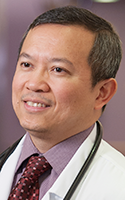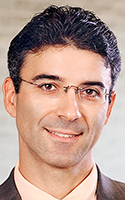By Matthew Liptak

When it comes to speed of treatment of an emerging stroke situation, Crouse Hospital might have an edge on time, but the stroke care programs at Crouse and Upstate Medical University have their strengths in the life-saving mission to care for those with the condition.
According to physician Julius Gene S. LaTorre, Upstate’s director of its comprehensive stroke program stroke, patients may receive treatment in as little as 11 minutes from the time they enter Upstate’s ER, though the average is 31 minutes. According to data sup-plied by Crouse’s director of nursing in neuroscience, the median time for a stroke patient to get in the door and then receive medical assessment is eight minutes. Officials from St. Joseph’s Hospital declined to offer comments for this story.
Both Crouse and Upstate hospitals usually prefer the patient to call an ambulance first so the hospital can be prepared when the patient arrives.
“As soon as the patient arrives in the emergency room everybody is ready to take care of the patient,” LaTorre said. “The first thing we do is bring a patient to CAT scan. We have made our protocol to bring the patient directly from the ambulance to the CAT scan to rule out any evidence of hemorrhage in the brain. If the patient continues to have symptoms of stroke and we don’t have any contraindication, then we give the patient a clot-busting medication called tPA.”
Crouse take the same strategy when admitting a stroke patient. And, like Upstate, it will often go ahead and do a medical procedure called a mechanical thrombectomy. A doctor inserts a catheter into the groin and can navigate a stent through the body to remove a clot.
“Nowadays with the new equipment we have it can take 20 to 30 minutes,” said the director of Crouse’s Neuroscience Institute, physician Eric Deshaies. “It’s less than the hours it used to take with the older equipment. There are windows for everything. The clot-busting drug can only be given within the first three to four and a half hours, and then the other things we do, typically it’s a six to eight-hour window. You do have some patients who will just wake up with a stroke and they don’t know if happens just when they woke up or if it happened hours before so we have a specialized CAT scan where we look at the blood flow in the brain, and based on those results determine an age of the stroke.”
Both doctors see reasons to be hopeful about stroke treatment. As time goes on more advancements for better care are being made.
LaTorre said stroke interventions are some of the most effective medical interventions there are in medicine today. There are more positive outcomes per case than other conditions.

“Treatment for stroke is getting better,” he said. “The time window is expanding. I wouldn’t be surprised if in the next one or two years we will have additional new effective treatments we can use to battle stroke.”
Crouse and Upstate offer clinical trials for stroke patients. Deshaies is excited about some of the groundbreaking work being done in neuroscience.
“They’re doing research on where they actually interface robotics with little grids on the brain,” he said. “It’s able to take those signals and transmit them and get a functional outcome. There’s a lot of hope in the future. They’re also doing some stem cell transplantation to try to regenerate some of these pathways, but we’re very, very early.”
Both doctors were asked by In Good Health why a patient should choose their institution for care.
“The most obvious thing is that we’re the only comprehensive stroke center in this region,” LaTorre said. “We have everything that the patient would ever need. There’s a very strict criteria to be accredited as a comprehensive stroke center. We’ve been accredited since 2015.”
“At Crouse we’re the only place in the region that has two highly specialized hybrid rooms where we can do both minimally invasive and maximally open surgery to treat the strokes and to treat the aneurisms at the same time,” Deshaies said. “We also are the only place in the region that has an expert endovascular neurosurgeon. We’re able to treat stroke.”
Wherever you wind up for treatment, the doctor’s from Crouse and Upstate agree time is critical in treating the condition successfully. They say patients should be aware of the “FAST” acronym when thinking about yourself and stroke: F for facial drooping; A for arm and leg weakness; S for speech difficulties, and T for time to call 911.
If you exhibit these symptoms get to a stroke program at once. If your successfully treated you could be on your feet again and out of the hospital in as little as a few days.
